eventloop 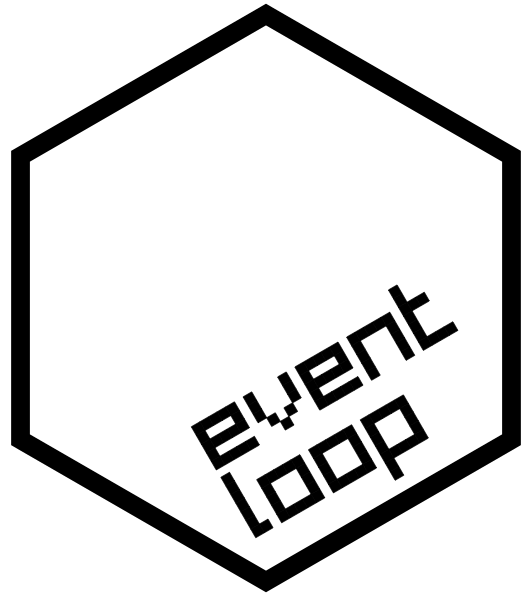
The {eventloop} package provides a framework for rendering interactive graphics
and handling mouse+keyboard events from the user at speeds fast enough to be
considered interesting for games and other realtime applications.
{eventloop} is a wrapper around the built-in event handling available in
base R as part of {grDevices}, but presents it in a more palatable format
with some enhanced features.
The {eventloop} package will:
- Initiate an
x11()window with monitoring for keyboard & mouse events.
- Capture events as they happen such that they will be available to the user-supplied function.
- Coordinate the setup of the user-defined callback function to be run continually with access to the latest event information presented as the function arguments.
- Optionally limit the frequency of screen updates by maintaining a frame-rate specified by the user.
At each call, the user’s function processes events and updates the display.
What’s in the box
run_loop()takes a user-specified function and calls it continuously within an event-driven loop.
Supported Platforms
| System | x11() device has ‘onIdle()’ event callback | System supported in {eventloop} |
|---|---|---|
| macOS | ✅Yes | ✅Yes |
| *nix | ✅Yes | ✅Yes |
| Windows | ❌ No | ❌ No |
Notes:
- windows
x11()device does not supportonIdlecallback and hence this package does not work on windows - macOS
x11()support is via Xquartz. Xquartz may slow to a crawl after running for a while. You will need to logout-and-log-back in, or restart your machine to regain full speed. This bug may be in Xquartz or how x11() support is implemented in macOS - I’m really not sure.
Installation
Pre-requisites
- Unix-like systems
- R compiled with X11() support
- macOS
- Xquartz installed
- windows
- Sorry, but R on windows does not support features needed for this package
# install.package('remotes')
remotes::install_github('coolbutuseless/eventloop')Example - Basic Drawing app
This is a basic application which lets the user draw in a window using the mouse.
library(grid)
library(eventloop)
#~~~~~~~~~~~~~~~~~~~~~~~~~~~~~~~~~~~~~~~~~~~~~~~~~~~~~~~~~~~~~~~~~~~~~~~~~~~~~
# Set up the global variables which store the state of the world
# 'drawing' = Is the mouse button currently pressed?
# last_x/last_y = the last mouse position is manually saved every time
# the callback function runs.
#
# These values will be updated manually by the user in the `draw()` function
#~~~~~~~~~~~~~~~~~~~~~~~~~~~~~~~~~~~~~~~~~~~~~~~~~~~~~~~~~~~~~~~~~~~~~~~~~~~~~
drawing <- FALSE
last_x <- NA
last_y <- NA
#~~~~~~~~~~~~~~~~~~~~~~~~~~~~~~~~~~~~~~~~~~~~~~~~~~~~~~~~~~~~~~~~~~~~~~~~~~~~~
#' Callback function - 'draw()'
#'
#' If 'event' is not NULL, then it means that the user interacted with the
#' display.
#'
#' The following events are handled by this callback:
#' - hold mouse to set drawing mode
#' - releasing the mouse button stops drawing mode
#' - pressing SPACE clears the canvas
#'
#' Press ESC to quit.
#'
#' @param event The event from the graphics device. Is NULL when no event
#' occurred. Otherwise has `type` element set to:
#' `event$type = 'mouse_down'`
#' - an event in which a mouse button was pressed
#' - `event$button` gives the index of the button
#' `event$type = 'mouse_up'`
#' - a mouse button was released
#' `event$type = 'mouse_move'`
#' - mouse was moved
#' `event$type = 'key_press'`
#' - a key was pressed
#' - `event$str` String describing which key was pressed. See \code{grDevices::setGraphicsEventHandlers} for more information.
#' @param mouse_x,mouse_y current location of mouse within window in normalised coordinates in the range [0, 1]. If mouse is
#' not within window, this will be set to the last available coordinates
#' @param frame_num Current frame number (integer)
#' @param fps_actual,fps_target the curent framerate and the framerate specified
#' by the user
#' @param dev_width,dev_height the width and height of the output device. Note:
#' this does not cope well if you resize the window
#' @param ... any extra arguments ignored
#~~~~~~~~~~~~~~~~~~~~~~~~~~~~~~~~~~~~~~~~~~~~~~~~~~~~~~~~~~~~~~~~~~~~~~~~~~~~~
draw <- function(event, mouse_x, mouse_y, ...) {
#~~~~~~~~~~~~~~~~~~~~~~~~~~~~~~~~~~~~~~~~~~~~~~~~~~~~~~~~~~~~~~~~~~~~~~~~~~~
# Process events
#~~~~~~~~~~~~~~~~~~~~~~~~~~~~~~~~~~~~~~~~~~~~~~~~~~~~~~~~~~~~~~~~~~~~~~~~~~~
if (!is.null(event)) {
if (event$type == 'mouse_down') {
drawing <<- TRUE
} else if (event$type == 'mouse_up') {
drawing <<- FALSE
last_x <<- NA
last_y <<- NA
} else if (event$type == 'key_press' && event$str == ' ') {
grid::grid.rect(gp = gpar(col=NA, fill='white')) # clear screen
}
}
#~~~~~~~~~~~~~~~~~~~~~~~~~~~~~~~~~~~~~~~~~~~~~~~~~~~~~~~~~~~~~~~~~~~~~~~~~~~
# If 'drawing' is currently TRUE, then draw a line from last known
# coordinates to current mouse coordinates
#~~~~~~~~~~~~~~~~~~~~~~~~~~~~~~~~~~~~~~~~~~~~~~~~~~~~~~~~~~~~~~~~~~~~~~~~~~~
if (drawing) {
if (!is.na(last_x)) {
grid::grid.lines(
x = c(last_x, mouse_x),
y = c(last_y, mouse_y),
gp = gpar(col = 'black')
)
}
# Keep track of where the mouse was for the next time we draw
last_x <<- mouse_x
last_y <<- mouse_y
}
}
#~~~~~~~~~~~~~~~~~~~~~~~~~~~~~~~~~~~~~~~~~~~~~~~~~~~~~~~~~~~~~~~~~~~~~~~~~~~~~
# Start the event loop. Press ESC to quit.
#~~~~~~~~~~~~~~~~~~~~~~~~~~~~~~~~~~~~~~~~~~~~~~~~~~~~~~~~~~~~~~~~~~~~~~~~~~~~~
eventloop::run_loop(draw, fps_target = NA, double_buffer = TRUE)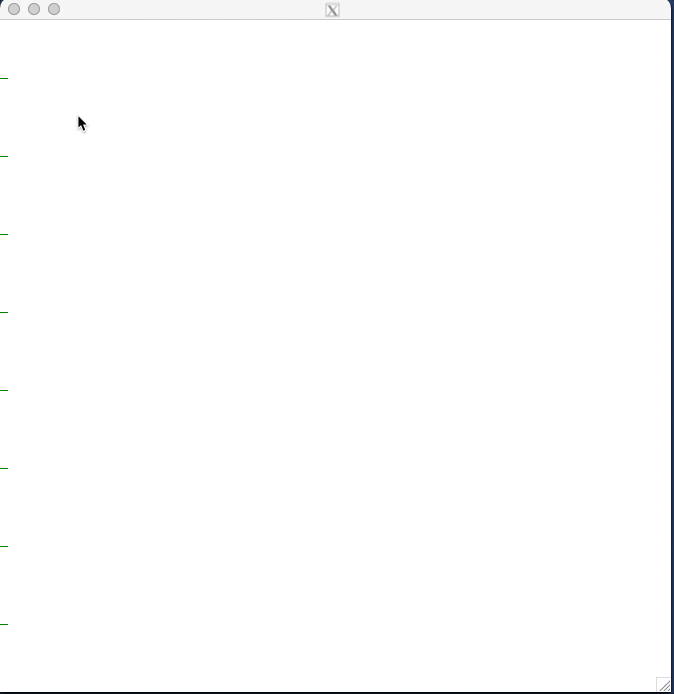
Notes:
- Every time the callback function
draw()is executed from within the event loop, it draws a line from the last mouse position to the current mouse position. - The position of the mouse during the previous call is saved manually using global variables.
- A boolean variable (
drawing) is used to note whether the mouse button is currently pressed or not. Changes to the screen only happend ifdrawing == TRUE.
Gallery of Puzzles, Games + Applications implemented in the vignettes
Click an image to view the code/vignette
The linked pages contain videos of realtime screen captures which illustrate how the interactive nature of these applications work.
All examples are written in plain R using the {eventloop} package.
Grid-based drawing 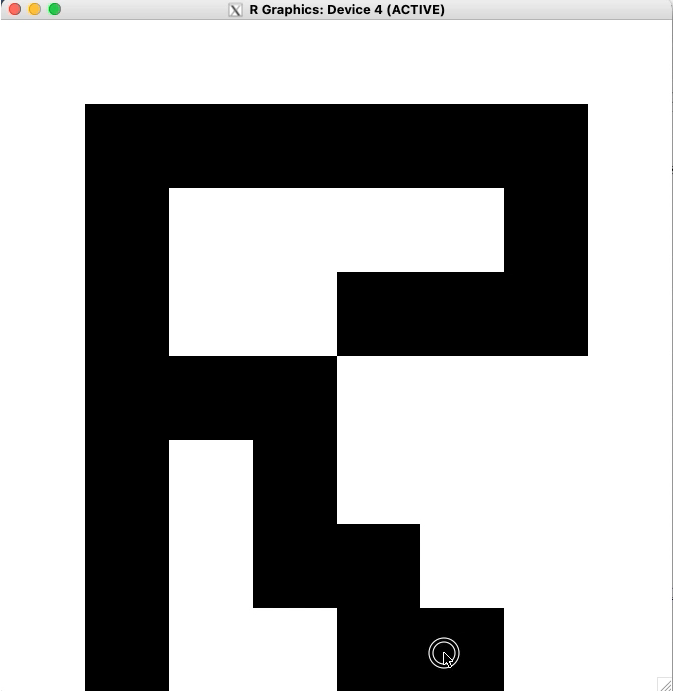 |
Line-based drawing  |
Streaming plot data 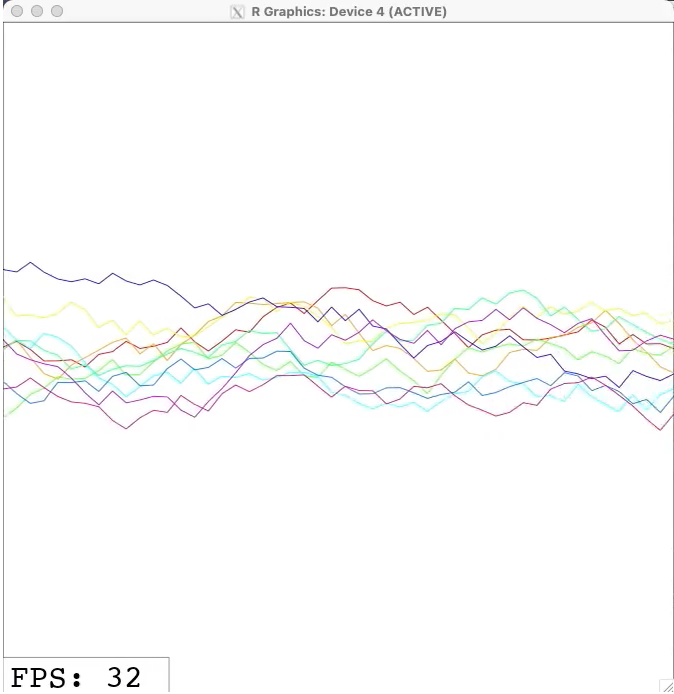 |
Game of Life 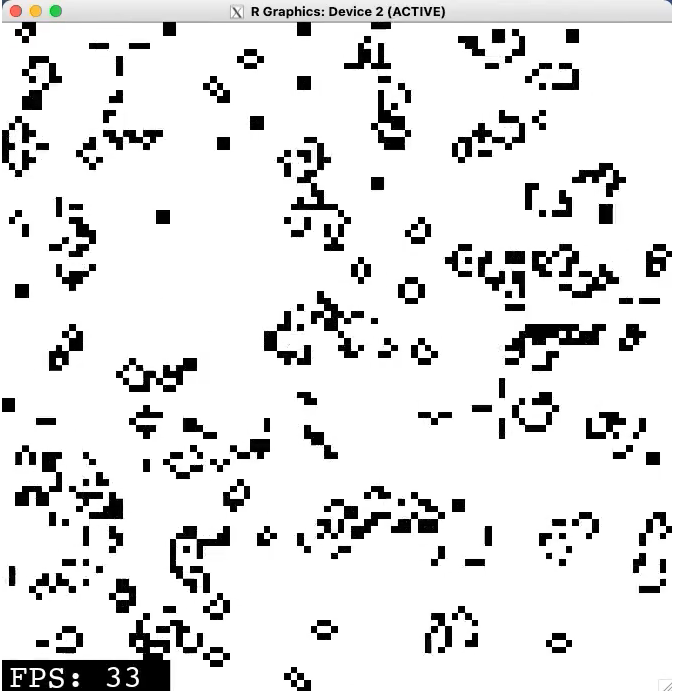 |
Asteroids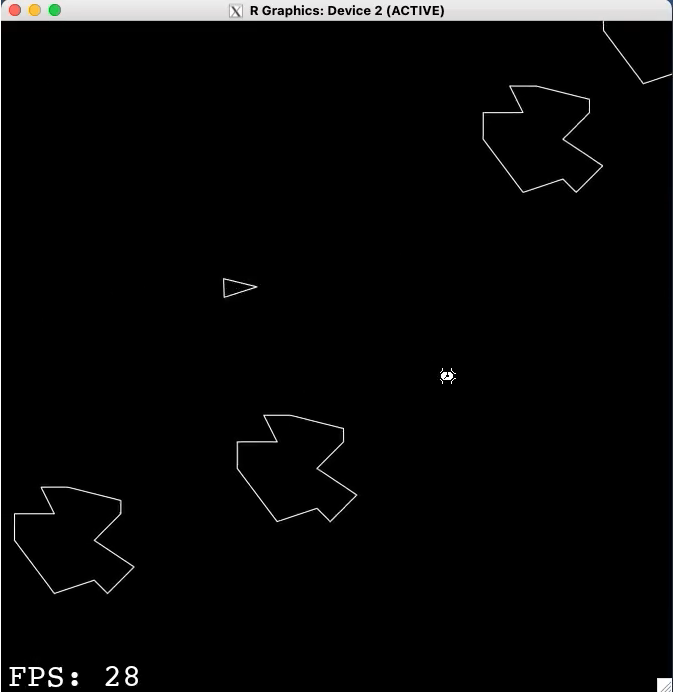 |
Raycast ‘Wolfenstein’ 3d engine 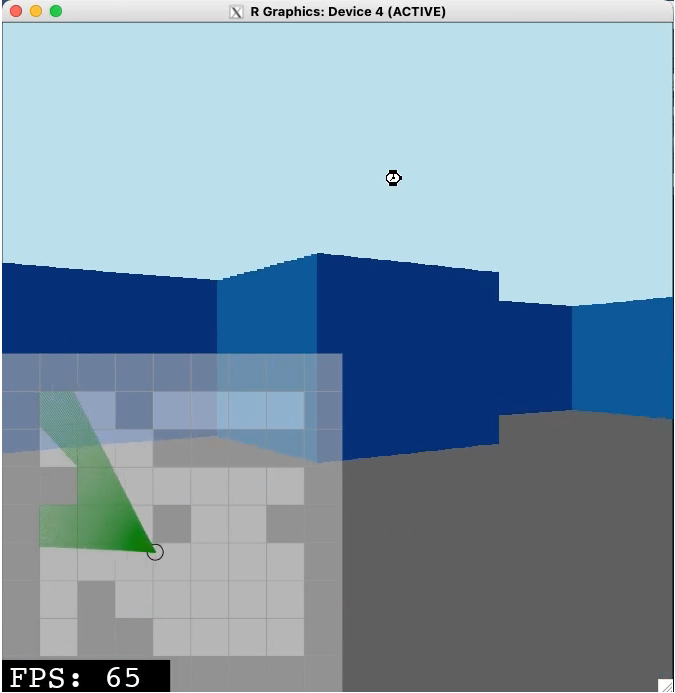 |
Wordle  |
Interactive Mystery Curves 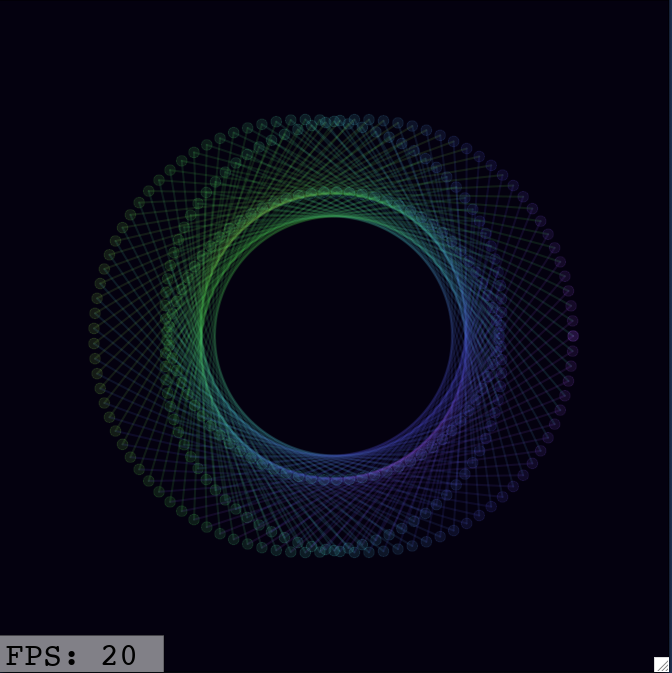 |
Verbose example  |
FAQ
Why is Windows not supported?
No graphics device on windows supports the onIdle callback, which is essential
to the workings of this package.
The Windows operating system supports the concept of an onIdle callback, but
no one has yet written this into the R graphics device on this platform.
Why does this run so slow on macOS sometimes?
Through some unknown combination of factors, after running x11() windows
on macOS for some number of times or duration, the system will slowdown from hundreds-of-frames-per-second
to just ten-frames-per-second.
This feels like a bug in either the XQuartz() x11 framework, or it could be
a bug within R in how it interfaces with XQuartz()
Note that I have not seen any slowdowns when using x11() devices on Linux machines.
Tech bits: What is an event loop?
gameprogrammingpatterns.com defines an event loop (also known as a game loop) as follows:
A game loop runs continuously during gameplay. Each turn of the loop, it
processes user input without blocking, updates the game state, and renders
the game. It tracks the passage of time to control the rate of gameplay.Tech bits: How is the event loop implemented in R?
Graphics windows in R can have event handlers attached which instruct the device to run a function when a certain event occurs.
When a mouse or keyboard event occurs, {eventloop} stores the event in
an environment for later access.
When there is no event occuring, another function is called continuously. This
function is the ‘onIdle’ event callback and is only available in the x11()
device on macOS and *nix.
The {eventloop} package orchestrates the events and window information into
arguments to the user-supplied ‘onIdle’ function - calling this function over and over
while the event loop is running.
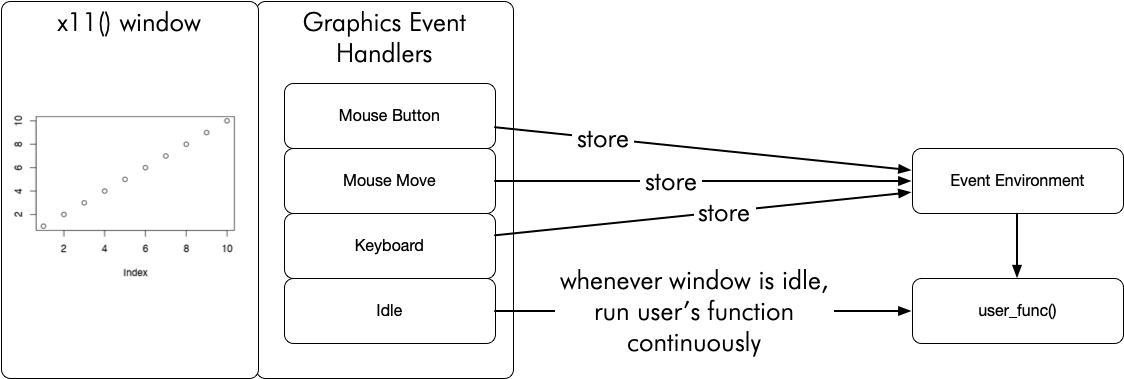
Acknowledgements
- R Core for developing and maintaining the language.
- CRAN maintainers, for patiently shepherding packages onto CRAN and maintaining the repository

